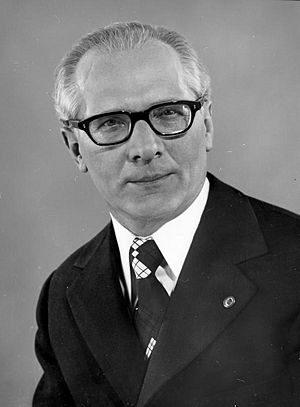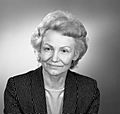Erich Honecker facts for kids
Quick facts for kids
Erich Honecker
|
|
|---|---|
 |
|
| General Secretary of the Socialist Unity Party of Germany | |
| In office 1971–1989 |
|
| Preceded by | Walter Ulbricht |
| Succeeded by | Egon Krenz |
| Chairman of the Council of State of the German Democratic Republic | |
| In office 1976–1989 |
|
| Preceded by | Willi Stoph |
| Succeeded by | Egon Krenz |
| Personal details | |
| Born | 25 August 1912 Neunkirchen, Germany |
| Died | 29 May 1994 (aged 81) Santiago, Chile |
| Political party | Socialist Unity Party of Germany |
| Spouses | Edith Baumann Margot Feist (1953-1994) |
| Profession | Politician |
Erich Honecker (born August 25, 1912 – died May 29, 1994) was an important East German Communist politician. He was the leader of the German Democratic Republic from 1971 until 1989.
After Germany became one country again, he went to the Soviet Union. However, the new Russian government sent him back to Germany. There, he faced questions about his time in power. He was very ill with liver cancer, so he was released from prison. He passed away in Chile about a year and a half later.
Contents
Early Life and Political Start
Erich Honecker was born in Neunkirchen, a town that is now in the Saarland region of Germany. He grew up with two brothers and three sisters.
In 1926, when he was 14, he joined the Young Communist League of Germany (KJVD). This was the youth group of the Communist Party of Germany (KPD). He then joined the KPD itself in 1929. From 1928 to 1930, he worked as a roofer, but he did not finish his training. After that, he went to Moscow to study at the International Lenin School. From then on, he worked as a full-time politician.
Honecker returned to Germany in 1931. In 1935, he was arrested after the Nazis took power. In 1937, he was sentenced to ten years in prison for his Communist activities. He stayed in prison until World War II ended. After the war, Honecker started working for the Communist Party again. He worked under the leader Walter Ulbricht. In 1946, he became one of the first members of the new Socialist Unity Party of Germany (SED). This party was formed by combining the old KPD and the Social Democrats from eastern Germany.
He became a member of the parliament in the part of Germany controlled by the Soviet Union after elections in October 1946. The German Democratic Republic was created on October 7, 1949. Its government system was similar to that of the Soviet Union. Honecker became a candidate member of the Central Committee's leadership group in 1950. He became a full member in 1958.
Leading East Germany
In 1961, Erich Honecker was in charge of building the Berlin Wall. In 1971, he began a struggle for power. The Soviet Union supported him, and he became the new leader, or General Secretary, of the Socialist Unity Party. He took over from Walter Ulbricht. In 1976, he also became the Chairman of the Council of State.
Under Honecker's leadership, living standards in East Germany improved a lot. Even though it was part of the Eastern Bloc, East Germany had the highest standard of living among those countries. More everyday items were made available to people. Also, new house-building projects were started and finished faster.
While Honecker focused on improving goods and housing, he did not allow people to criticize the government. The Berlin Wall was a clear example of this. During his time as leader, about 125 East German citizens died trying to cross the border into West Berlin.
In terms of foreign relations, Honecker never wanted Germany to be a single country again. He was very loyal to the USSR. However, he did accept a policy called détente. This meant becoming friendlier with Western countries. Under his government, East Germany even became friendlier with West Germany. In September 1987, he became the first East German head of state to visit West Germany.
In the late 1980s, Soviet leader Mikhail Gorbachev introduced new ideas called glasnost and perestroika. These were reforms to make communism more open. However, Honecker and the East German government refused to make similar changes in their country. As the reform movement spread across Central and Eastern Europe, people started protesting against the East German government. The biggest protests were the 1989 Monday demonstrations in the city of Leipzig. Other leaders in East Germany decided that Honecker had to go. They forced him to resign on October 18, 1989. Egon Krenz took his place.
After 1989
After Germany became one country again, Honecker stayed in a Soviet military hospital near Berlin. Then, he and his wife went to Moscow. This was to avoid facing legal questions about his actions during the Cold War. The German government said he should be questioned because many East Germans died trying to leave East Germany. After the Soviet Union broke apart in December 1991, Honecker went to the Chilean embassy in Moscow. But Boris Yeltsin's government sent him back to Germany in 1992.
His legal proceedings started in early 1993. However, Honecker was released because he was very ill. On January 13, 1993, he moved to Chile to live with his daughter Sonja, her Chilean husband Leo Yáñez, and their son Roberto. He died from liver cancer in Santiago, Chile, on May 29, 1994.
Family Life
Honecker married Edith Baumann in 1950, but they divorced in 1953. They had a daughter named Erika, who was born in 1950. In 1953, he married Margot Feist. They stayed married until he died. They had a daughter named Sonja, born in 1952. Margot Honecker was the Minister for National Education in East Germany.
Famous Sayings
- "The Wall will be standing in 50 and even in 100 years, if the reasons for it are not removed." (Berlin, January 19, 1989)
- "Neither an ox nor a donkey is able to stop the progress of socialism." (Berlin, October 7, 1989)
Books About Honecker
Honecker wrote a book about his life called Aus meinem Leben. It was translated into English as From my life.
- New York : Pergamon, 1981. ISBN: 0-08-024532-3
- Fulbrook, Mary, The people's state : East German society from Hitler to Honecker, Yale University Press, c2005.
| Preceded by Walter Ulbricht |
General Secretary of the Socialist Unity Party of Germany | Succeeded by Egon Krenz |
| Preceded by Willi Stoph |
Chairman of the Council of State of the German Democratic Republic |
Images for kids
-
Honecker at the CSCE summit in Helsinki, 1975
-
Honecker, with Gorbachev on his right, at the forefront of East Germany's 40th anniversary celebration, shortly before being forced to resign
-
Egon Krenz introduces himself to the People's Chamber as Honecker's replacement for general secretary
See also
 In Spanish: Erich Honecker para niños
In Spanish: Erich Honecker para niños











